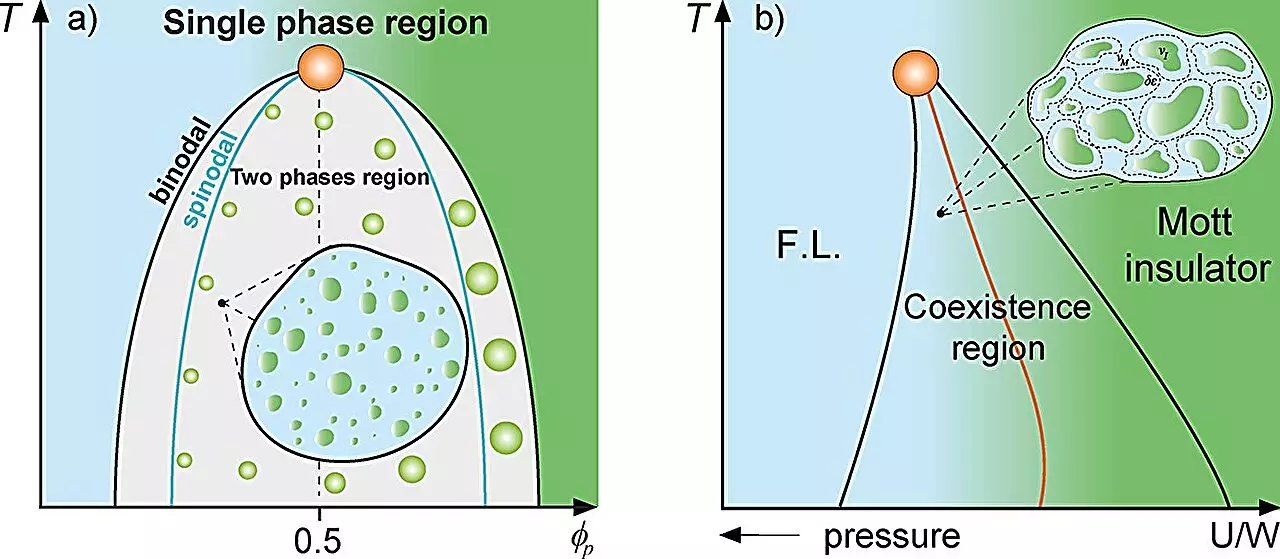In the realm of cellular biology, understanding how proteins interact and coexist within cells is a critical aspect of deciphering cellular functions and behaviors. Recent advancements have propelled our comprehension of phase separation in biological environments, particularly the phenomenon where liquids separate into distinct phases—a process vital for numerous biological functions. This phase separation can lead to the formation of protein droplets, crucial for a variety of cellular processes, which researchers at São Paulo State University (UNESP) have explored in the context of Griffiths-like phases.
Theoretical Foundations and Application
The theoretical framework guiding this exploration is rooted in condensed matter physics, where mixture theories were first established to explain the behavior of systems comprising multiple components. These theories have been extended to elucidate phenomena in biological systems, as demonstrated in the recent study published in the journal *Heliyon*. Researchers, spearheaded by professor Mariano de Souza and Ph.D. candidate Lucas Squillante, draw analogies between the magnetic Griffiths phase and the dynamics of protein droplets formed through liquid-liquid phase separation. In essence, both systems are characterized by the emergence of “rare regions” that significantly influence the overall dynamics of the system.
In the original study, the authors employ thermodynamic concepts to reveal how the motility and dynamism of cellular components are hampered near the binodal line, a critical threshold demarcating phase separation. Utilizing established models such as the Grüneisen parameter and the Flory-Huggins model, they articulate how shifts in protein concentrations can lead to dramatic changes in protein behavior, hence proposing the existence of a Griffiths-like cellular phase that is environmentally sensitive.
The implications of these findings extend beyond mere cellular behavior; they venture into the origins of life itself. Oparin’s theory postulates that the primordial life forms arose in environments rich with coacervates—structures central to the early biogenesis. This research posits that cellular dynamics, influenced by liquid-liquid phase separation, may have played a pivotal role in the emergence and evolution of these coacervates.
Furthermore, the link between phase dynamics and chirality offers intriguing insights into biological evolution. Chiral molecules, which cannot be superimposed on their mirror images, are fundamental to the molecular assembly of life. Homochirality, the dominance of a particular chiral form in biological systems, suggests that the slow dynamics associated with these protein droplet formations may have favored the stability and evolution of the earliest life forms.
The study’s relevance extends to pathologies where liquid-liquid phase separation is widely implicated, such as neurodegenerative diseases and cancer—a connection established through an exploration of how protein compartmentalization can influence cellular mutation dynamics and functionality. The researchers suggest that an understanding of the Griffiths-like cellular phase could reconcile the complexities of protein behavior underlying these diseases.
In tumors, for instance, the compartmentalization of mutated protein products can affect their functionality, thereby influencing cell survival and proliferation. Similarly, conditions like cataracts and COVID-19 have been linked to aberrant phase separations, where proteins behave atypically, leading to cellular dysfunction. Professor Marcos Minicucci emphasizes that while liquid-liquid phase separation can sometimes detract from cell functionality, a deeper understanding of the Griffiths-like cellular phases can provide pathways to developing targeted therapeutic strategies.
Interdisciplinary Approach and Future Implications
This innovative research exemplifies the importance of an interdisciplinary approach in scientific inquiry, merging principles from physics and biology to tackle complex problems inherent to both fields. By elucidating how protein dynamics can be understood through the lens of condensed matter physics, the researchers have opened new avenues for investigation in cellular dynamics and disease management.
The study notably features collaboration across institutions and countries, reinforcing the idea that complex biological phenomena such as protein phase separation require comprehensive approaches that leverage diverse areas of expertise. Moving forward, the questions raised regarding gene expression optimization and implications for treatment strategies present exciting avenues for research, with the potential to precipitate groundbreaking developments in health and disease management.
The examination of Griffiths-like phases in cellular dynamics offers rich insights into the fundamental nature of proteins within cellular environments. As research continues to unfold, it is evident that the interplay between phase separation and protein behavior bears significant implications not only for our understanding of cellular mechanics but also for the treatment of diseases increasingly recognized as influenced by protein dynamics. The ongoing dialogue between physics and biology promises to sculpt the future of biomedical research, inviting further exploration into the myriad ways in which cells orchestrate their internal symphonies.

